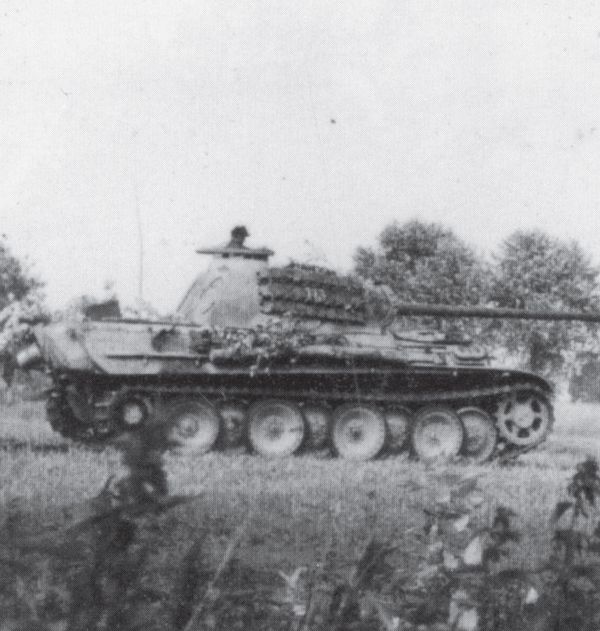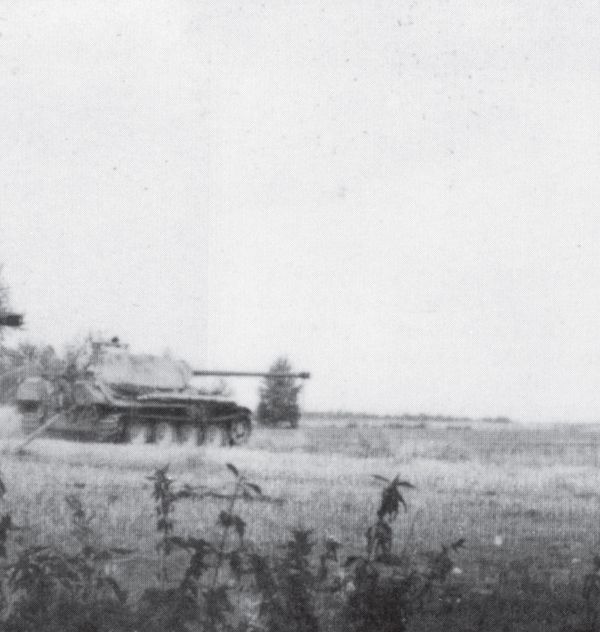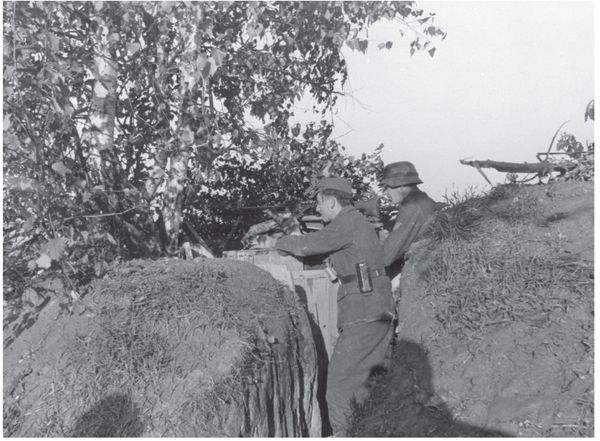Warszawa II (16 page)
Authors: Norbert Bacyk

The situation for both SS- panzer divisions now became critical. Opposing them were three armies (more concretely: six rifle corps, as the 70th Army had only two; one corps from the 28th Army fought against the XX Army-Corps, while the 47th Army's 125th Rifle Corps stood inactive across from the 73rd Infanterie-Division) and two armoured corps, plus countless artillery and combat aircraft. The losses were enormous and only some tens of tanks per-regiment were battle-worthy. The 5th SS-Panzer-Division “Wiking” had been driven out of TÅuszcz and organised a new defence line along the main road to BiaÅystok between Trojany and Zabrodzie. With the aim of reinforcing Gille's ever weaker corps, General Reinhart ordered that the Hungarian reserve, the 1st Cavalry Division, be re-deployed to Praga. Also ordered to arrive in Praga was the 1145th Grenadier-Regiment from Warsaw, which up until that time been part of von dem Bach's corps and had helped to crush the Uprising. SS-Obergruppenführer and polizeigeneralen Erich von dem Bach opposed this decision with the argument that his pacification troop was already weak. The order, however, continued in force. In addition, the 1131st Grenadier-Brigade was put under the operational command of the severely mauled 3rd SS-Panzer-Division “Totenkopf” in the defence of WoÅomin.
A tracked assault-gun StuG 40 Ausf. G from SS-Panzer-Division “Totenkopf” or the 5th SS-Panzer-Division “Wiking” waiting in ambush in the vicinity of Warsaw, in August 1944.

At this time, new operational plans were meanwhile being drawn up in Moscow dealing with, among other things, the fighting in central Poland. It was a cheerless satisfaction Zjukov felt when, as he had foreseen, the weakened force of Soviet attacks now began to be clearly evident. Soviet forces continued to fight hard, but the officers at Soviet headquarters knew that a breakthrough in the German frontline along the Wisla was not going to be achieved in the immediate future. To all appearances, Stalin was not concerned about this. The Soviet dictator was now completely focused on the Balkans where the 2nd and the 3rd Ukrainian Fronts were poised to launch a new strategic offensive. He also wanted to strike against East Prussia and decide the battle for control of the Baltic States. Zjiukov informed him that it was necessary to carry out a reorganization of several armies and to give them new objectives. Moreover, it was necessary to concentrate large amounts of supplies and reinforcements to the Balkans and this would primarily be at the expense of Konev and Rokossovskij's armies. Stalin did not debate the viewpoints of his “representatives.” And on August 20, the 1st Belorussian Front and the 4th Guards Cavalry Corps were already on their way south. This had, to some significant degree, an impact on the battles for Warsaw since, on that sector of the front which these forces had up until then occupied; there now remained only the 2nd Guards Cavalry Corps. Clearly, this weakened the combat strength of the forces storming the Warsaw region.

Two Panther tanks from the 3rd SS- Panzer- Division “Totenkopf” advance towards the enemy, Warsaw district, August 1944. (Leandoer & Ekholm archive)

The issue of the Warsaw Uprising was dealt with separately. Stalin was surprised that the insurgent opposition had lasted so long. For the Germans, who had primarily regular troops along the front, it was increasingly apparent that they did not have enough combat strength to quickly regain control of the city. According to Stalin, Marshal Rokossovskij should not, as yet, attack Praga itself, but instead concentrate his focus on liquidating the enemy in the WoÅomin-Wyszków region. Obviously, the most important objective of his frontline for the immediate future was to continue to maintain and even expand the troop positions along the Wisla. Likewise, the 2nd Army should be smashed and the Narew crossed.
The final days of August constituted a period of seldom-seen, brutally intensive fighting. Soviet pressure on the IV SS-Panzer-Corps let up on August 20, which immediately resulted in German counterattacks. The local counteroffensives which the 3rd SS-Panzer-Division “Totenkopf” and the 5th SS-Panzer-Division “Wiking” conducted were aimed to “even out” the frontline between Radzymin and Wyszków: This, because the 70th Army in earlier fighting had managed to carve troublesome pockets between various districts of defence. On August 21, the tank grenadiers (from the 3rd SS-Panzer-Division “Totenkopf” and the 5th SS-Panzer-Division “Wiking”) led counter-attacks to regain control of the main road to BiaÅystok, which temporarily removed the risk that both Waffen-SS tank divisions would be separated from one other. Although the SS-soldiers' tanks and anti-tank guns caused incredible losses in terms of combat equipment for the Soviet attackers; the disproportionate combat strength favouring the 70th Army on August 24 enabled them to once again cut off the road to BiaÅystok near the village of Trojany. Volunteers from the 5th SS-Panzer-Division “Wiking” fought frenetically and managed to beat back repeated attacks by the Soviet infantry, which had the support of tanks from the 8th Guards Tank Corps. The Germans had the Bug River at their backs, and were the division's positions to give way, it would cease to exist. The commander of the 70th Army , General Popov (the army was led by Vasil Popov while Alexei Popov had command of the 8th Guards Tank Corps), strove to cross the Bug from the village of Trojany to Marianów on the other side. It did not succeed, however, until August 25, despite one of the 28th Army's rifle corps engaging half the 5th SS-Panzer-Division “Wiking's” combat strength due south of Wyszków.
Two Sd Kfz 251/1's ausf D very near the frontline. Note the soldier standing on the front of the first half-track, this was a common means of carrying out reconnaissance providing a view over the crown of a road. Both vehicles hail from the 19th Panzer-Division, August 1944 outside Warsaw. (Leandoer & Ekholm archive)

The 47th Army's 77th and 129th Rifle Corps simultaneously attacked WoÅomin from the east, and the village of Zabraniec which lay south of it. Defence of the village, which lay in ruins, was the responsibility of a combined unit composed of the 3rd SS-Panzer-Division “Totenkopf” and the 1131st Grenadier-Brigade, while the stretch of area to the south was manned by the Hungarian 1st Cavalry Division. The Germans took a pause from the fighting but, due to lack of modern weaponry, the Hungarians were beaten down and withdrew towards Zielonka and Rembertów. In an effort to save the situation, SS-Gruppenführer Herbert Gille supported the cavalry division with units from the 73rd Infantry-Division, effectively halting further Soviet successes. In the end, the front along the WoÅomin â Dluga River â Okuniew line was temporarily stabilised.
The fighting that had taken place was extremely bloody. According to a report from the “War-diary of the 9th Army,” the IV SS-Panzer-Corps â taking into account only the days between August 18 and August 22 â destroyed 249 Soviet tanks and tracked artillery. Balancing this, however, was the fact that for all practical purposes the Soviet air force had liquidated this German corps' artillery. Many troops had fallen, forcing the combining of combat entities, as for example: the 3rd SS-Panzer-Division “Totenkopf ” and the 1131st Grenadier-Brigade. Holding the main Radzymin-Wyszków road became impossible. North of the Bug, the German 2nd Army, under pressure from the 48th and the 65th Armies, withdrew to the other side of the Narew. Gille now began to withdraw the rest of the 5th SS-Panzer-Division “Wiking” towards the west, where together with the 3rd SS-Panzer-Division “Totenkopf ” it would form the new ÅlÄżany-Zawady-RzÄ
da Brook defence line, east of Serock. With this objective in mind, von Vormann ordered General von Lüttwitz to immediately re-deploy the 19th Panzer-Division, with the exception of Panzer-Regiment 27, to the IV SS-Panzer-Corps. Eighty tanks would halt outside of Magnuszew, while the 73rd and 74th Panzer-Grenadier-Regiments, as well as Panzer-Artillery-Regiment 19, would support the 5th SS-Panzer-Division “Wiking” in its fight to retain control of the river's outflow.
German infantry, Poland, summer 1944. (ADM)

On August 26, the Soviet troops commenced the next assault with the support of massive artillery fire. Along the southern bank of the Bug, units from the 28th Army clashed with the Germans as they attempted to cross the river and strike at the XX Army-Corps' rearguard. The Germans quickly eliminated these bridgeheads but despite this momentary success, the 2nd Army's main fighting force was soon cut down and driven back during the first week of September across to the other side of the Narew. Prior to this, the biggest apparent problem at the location where the zones of the 9th and the 2nd Armies met involved the frontline fighting being conducted by the combined combat strength of the 5th SS-Panzer-Division “Wiking” and the 2nd Army. Rifle divisions of the 28th Army with support from a mass of T-34s and “Shermans” seized ÅlÄżany on August 27, and during the fighting that followed, the villages of Czarnów and Kuligów were also seized. The commander of Heeresgruppe “Mitte,” General Reinhart, interpreted the enemy manoeuvre as a preparatory action for intensifying pressure in the area of the Bug's discharge, with the goal of attacking the isolated rearguard of the 2nd Army which was engaged in the fighting outside Wyszków. Thinking along the same lines, von Vormann gave Gille the order to launch an immediate counter-attack. Tanks from SS-Panzer-Regimen 5 together with the panzer-grenadiers from the 19th Panzer-Division attacked Kuligów and Czarnów. Initially, the German fire power forced the Soviet infantry to give ground and two of their tanks were knocked out. But then a number of attacking tanks drove into a swampy marsh which they had not noticed bordering the banks of the Bug: The counter-offensive fell apart. During their withdrawal the Germans were forced to blow up twelve of their own tanks and assault guns. An unexpected order from the commander of the 9th Army instructing the 19th Panzer-Division, at the combat ready, to return to Magnuszew, further weakened the 5th SS-Panzer-Division “Wiking.” The only unit left to provide it support was Panzergrenadier-Regiment 73.